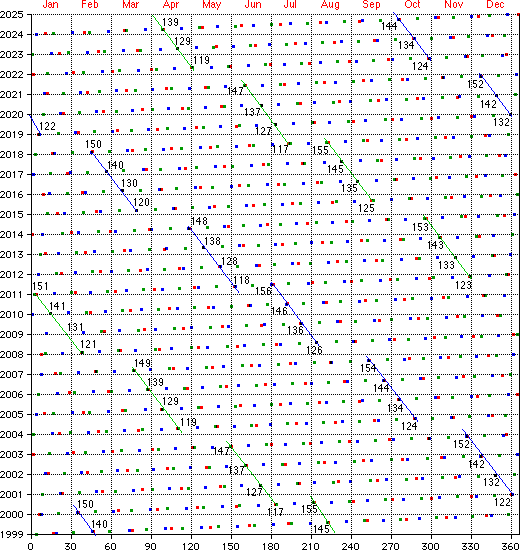Saros Numbers of Solar Eclipses 1999 to 2024

|
|
![]()
![]()
ascending node
descending node
|
The periodicity and recurrence of eclipses is governed by the saros cycle, a period of approximately 6,585.3 days (18 years 11 days 8 hours). It was known to the Chaldeans as a period when lunar eclipses seem to repeat themselves, but the cycle is applicable to solar eclipses as well. Saros series contain 69 to 86 eclipses. Every series begins with a number of partial eclipses near the north or south polar regions. The series will then produce several dozen central eclipses before ending with a group of partial eclipses near the opposite pole. Odd numbered Saros series occur at the ascending node of the Moon's orbit. They begin with a partial eclipse at high northern latitudes. Even numbered Saros series occur at the descending node of the Moon's orbit and start with a partial eclipse at high southern latitudes.
A solar eclipse will be total if the new Moon is at perigee (closest to the Earth, making it look larger) and the sun is at apogee (farthest from the Earth, making it look smaller, around January 3) During an annular eclipse, the sun looks like an "annulus" or ring. The ring is visible when the Moon does not entirely cover the disk of the Sun during a solar eclipse. This type of eclipse happens when the Sun is at perihelion (closest to the Earth, making the solar disc appear larger, around July 4) and the Moon is at apogee (farthest from the Earth, making it look smaller). |
Solar Eclipses 1999 to 2024
![]() Eclipse
Home Page (Fred Espenak)
Eclipse
Home Page (Fred Espenak)
|
Type: Date / UT / Type / Saros # 1999 Feb 16 06:34 A 140 2000 Feb 05 12:49 P 150 2001 Jun 21 12:04 T 127 2002 Jun 10 23:44 A 137 2003 May 31 04:08 An 147 2004 Apr 19 13:34 P 119 2005 Apr 08 20:36 H 129 2006 Mar 29 10:11 T 139 2007 Mar 19 02:32 P 149 2008 Feb 07 03:55 A 121 2009 Jan 26 07:59 A 131 2010 Jan 15 07:06 A 141 2011 Jan 04 08:51 P 151 2012 May 20 23:53 A 128 2013 May 10 00:25 A 138 2014 Apr 29 06:03 A- 148 2015 Mar 20 09:46 T 120 2016 Mar 09 01:57 T 130 2017 Feb 26 14:53 A 140 2018 Feb 15 20:51 P 150 2019 Jan 06 01:41 P 122 2020 Jun 21 06:40 Am 137 2021 Jun 10 10:42 A 147 2022 Apr 30 20:41 P 119 2023 Apr 20 04:17 H 129 2024 Apr 08 18:17 T 139 |
© 2005 Juergen Giesen
![]()